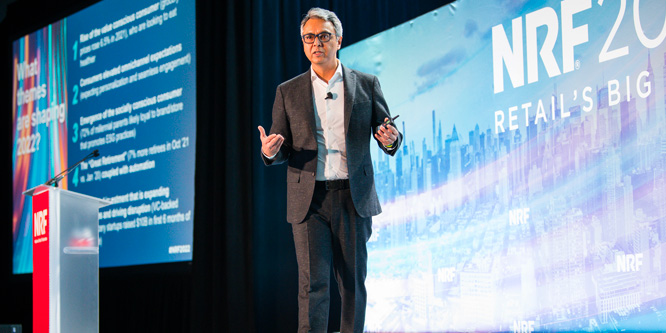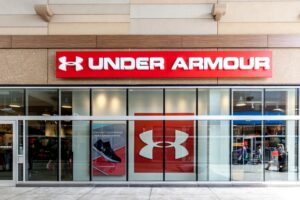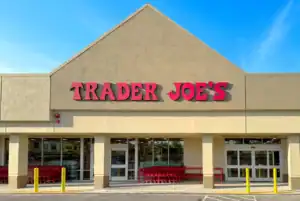
Sajal Kohli of McKinsey & Company speaking at NRF 2022 – Photo: NRF
January 25, 2022
NRF 2022: Grocers stay prepared for tomorrow’s new and unexpected challenges
Sajal Kohli, senior partner and global leader of consumer goods and retail practice, McKinsey & Company, started his presentation last week at the NRF Big Show with perhaps the biggest understatement of the year so far. He said that this is an unprecedented moment in time to be a grocer.
What was new (and interesting) in the McKinsey research was its finding that trends that accelerated during the pandemic will maintain velocity as consumers and the industry move to the next stage. Also interesting were trends not included on its list.
He began with some of the numbers that got us to where we are. Sales in the grocery online channel rose 58 percent from 2019 to 2021. The 8.7 percent increase in food-at-home expenditures during this period was four times the historical growth rate. There has been a 16.8 percent reduction in food away-from-home, and the foodservice sector won’t fully rebound in the short-term.
Mr. Kohli said the primary themes shaping 2022 and beyond include the rise of the value (inflation-driven), social (ESG-driven) and health conscious consumer (lifestyle-driven). We’ll also see more focus on personalized and seamless omnichannel engagement, the “Great Retirement” and automation. Pushing these themes are the facts that 56 percent of consumers believe the economy will be impacted for at least the short-term and 61 percent of consumers are still waiting for their routines to return to normal.
Absent from Mr. Kohli’s list are some of the themes this space and others have given significant coverage to over the past several years. Think of diet-focused trends like gluten-free and last-mile trends like buy online, pickup in-store. Also left out were trends like meal subscriptions services and everything local.
Mr. Kohli said retailers are making significant investments in expanding capabilities and driving disruption in the retail food ecosystem. They are developing partnerships to modernize their tech stack, pursue automation, drive efficiencies in the last mile and create new, innovative value propositions.
Discussion Questions
DISCUSSION QUESTIONS: What is your take on the themes that will have the strongest impact on the way grocery retailers operate their businesses in 2022? How can grocers best address the challenges and related opportunities?
Poll
BrainTrust
Lisa Goller
B2B Content Strategist
Ananda Chakravarty
Vice President, Research at IDC
Gwen Morrison
Partner, Candezent & Retail Cities Consultant
Recent Discussions







I think we will see sustained growth in both the expensive (healthy, organic, sustainable) categories and in the value categories (thanks to continued inflation and economic bifurcation). As such, the more targeted offers with promotions that have strong “gravitational pull” on other items will be an important part of the future of grocery operations. As will last-mile execution (even if not cited in the McKinsey study). I suspect there is a major shakeup coming in the grocery delivery space, as grocers tire of the premiums paid to Instacart and their ilk, and those who execute the best will find both share and margin opportunities.
For grocers, multichannel has become essential. Those who are getting the logistics right—and the tech that supports it—will continue to win. MFCs (micro-fulfillment centers) have become essential to filling orders coming in from all angles. On a brand loyalty note, research has shown that consumers are most likely to switch brands after a move. Will the “move” to online, BOPIS, and home delivery mean customers are more likely to at least try other local grocery chains they had never stepped foot in before? One thing’s for sure, the old line “You gotta eat” is still true. Like it or not, grocers have had to figure out how to keep shoppers connected with the foods and beverages they need. And as online groceries have taken hold, many shoppers no longer think local when they need to restock—or splurge.
Automation and speed will have the strongest impact on grocery operations.
Retailers will automate fulfillment and source products online for efficiency. They will rely on data to monitor and protect product availability. In stores, expect to see more cashierless tech and smart carts.
Rapid delivery will intensify, as grocers, convenience stores and food apps race to our doorsteps. Ghost kitchens and dark stores will fill real estate vacancies to meet tight delivery timelines. Also, local sourcing will shorten the supply chain for speed to market.
Collaborating with trading partners to digitize retail processes can make grocers’ supply chains agile and efficient.
We have created savvy customers over the past 2 years. Frozen food appliances have sold heavily. People bought frozen foods, and purchased more foods they can freeze. This mentality creates challenges to the food industry. People will be price sensitive on the whole. In other words, “Grocers must stay prepared for tomorrow’s new and unexpected challenges” There again, all retail is going back to school.
What’s also missing is the innovation CPG partners will bring to the table. My colleague at Kantar, Amar Sing talks about vendors who are creating integrated ecosystems of automation tools, interactive digital shelves, and AI solutions to drive operational efficiencies and shopper engagement. There is also the integration of predictive analytics and data capture within store environments that will improve inventory levels and in turn shopper satisfaction.
Whilst it is true that eating in massively increased during the pandemic, that is not exactly an earth shattering discovery as people were not allowed to eat out. Will it continue or more importantly, how long will it take for the balance to return is a different matter. People have found a new interest in cooking and that is good for grocers as not only will it maintain the ground they gained in lockdown it is likely to also increase the average spend as consumers take more interest in what they buy and more variety.
However, shopping local and consumers wanting to be more aware of where their food comes from is likely to have just as big an impact on grocers as they need to consider local sourcing and meeting the customer drive for more local product. There is also a greater interest in the reduction of food waste, vegetarianism and vegan diets, which will further change the landscape of ranging at grocers. Numbers may still be relatively small but more people are reducing their dependence on meat at least in part and are looking to reduce their food waste.
Retailing has never been static and be very sure that the next few years will have so much going on it is going to be a very exciting time.
Mr. Kohli brings up some great points and does a thorough analysis of the retail food ecosystem, but he also suggested in a presentation at FMI about a year ago that grocers need to reduce personnel costs by 20-30%. This can’t be achieved without some important steps. He brought up some great ideas on being bold, and many of them resonate with the industry — personalization, ecommerce/digital, supply chain optimization — all of these are good steps, but a more intrinsic theme runs through all of these.
What resonated with me was his thoughts on automation — in the back office and in the store. Grocery is undergoing the “Great Automation” as we speak with new engagement towards intelligent retail (both AI powered as well as data-based decision making). This means automated warehouses, shipping routes, supply sources. This means autonomous checkouts, self-checkouts, automated kiosks and store engagement. This means automated merchandising, product selection, reordering, and planogramming. This means automated delivery, simplified fulfillment, and optimized last mile options. This means digital optimization of customer engagement, personalized experiences, and customer-focused options based on customer needs at the time.
We’ll continue to see these evolve with testing, innovation, and partnerships and begin with taking bolder steps and executive decisions that commit spend in digital, in automation, and trying out new things. The Krogers, Albertsons, and Walmarts of the world that are willing to drive innovation through labs and idea validation will have the advantage in these unprecedented times.
Collaboration will be a critical theme between the grocers and their wholesale distribution partners. The great digital acceleration spurred on the pandemic has required grocers and wholesale distributors to take a more progressive approach with digital transformation efforts, merchandising, assortment optimization, pricing optimization, BOPIS, and micro-fulfillment strategies.
With these digital imperatives, sustainability, transparency, and holistic living trends will be the prevailing themes in the grocery industry throughout 2022. We should expect grocers and their wholesale distributor partners to take the necessary steps to offer more localized assortments. Consumers also expect a greater level of transparency in the sourcing processes. The rise of conscious consumerism extends into the grocery space, as the consumers are more interested in product sourcing and ingredients. Holistic living and organic foods will be a crucial differentiator for grocers in 2022 and beyond.
Branded voice platforms will be “the next big bang” in grocery marketing. Voice will become the customer’s direct response to personalized data-driven merchandising, advertising, promotion, and loyalty tactics. Voice will be the in-the-moment link between customer and banner. Think about this, 85+% of customers have their smartphone with them all the time and many spend on average 4+ hours on their device each day.
And I must add, the right voice platform will NOT require adding the to the banner’s tech stack.
Sajal is correct — grocers have a huge challenge ahead. Adapting their business to evolving consumer needs. Stores also need to be re-optimised to reflect their evolving purpose — they need to become hubs for omnichannel retail — pick-up, distribution as well as “traditional shopping.” Technology will need to play a significant part in automating, but also helping in-store teams adapt to their new expanded roles and responsibilities. Very difficult times, but also very exciting.
The future of grocery retailers is to drive greater engagement with shoppers. Mr. Kohli is absolutely right that it will be done by leveraging value. In a value-oriented world, grocers have the opportunity to try some really interesting, creative promotions that go beyond just simply slashing prices. To take advantage of this opportunity, grocers should focus on value creation. To do so, they need think through the correlation between consumer behavior and action—what are the most impactful ways to move units and drive more repeat shopping trips?
Personalization plays a pivotal role in this (will a promotion delivered now or one that can be used later be most impactful to our shoppers?) as does delivering a seamless omnichannel experience (how do we reach this shopper and is our message and offer the same across channels?).
Consumers are imminently predictable but extremely savvy, so taking time to engage with your consumers across multiple channels, find the right partners and get to know your shopper through smart data will ultimately ensure grocers succeed.